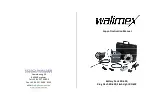
which can be determined by turning the equipment off and on,
the user is encouraged to try to correct the interference by one
or more of the following measures:
• Reorient or relocate the receiving antenna.
• Increase the separation between the equipment and receiver.
• Connect the equipment into an outlet on a circuit different from that
to which the receiver is connected.
• Consult the dealer or an experienced radio or television technician
for help.
If necessary, the user should consult the dealer or an experi-
enced radio/television technician for additional suggestions.
The user may find the following booklet helpful: “Something
About Interference.” This is available at FCC local regional
offices. Honeywell is not responsible for any radio or television
interference caused by unauthorized modifications of this
equipment or the substitution or attachment of connecting
cables and equipment other than those specified by Honeywell.
The correction is the responsibility of the user.
Caution: Any changes or modifications made to this equipment
not expressly approved by Honeywell may void the FCC autho-
rization to operate this equipment.
UL and C-UL Statement
UL and C-UL listed: UL60950-1, 2nd Edition and CSA C22.2
No.60950-1-07, 2nd Edition.
Canada
Industry Canada ICES-003
This Class B digital apparatus complies with Canadian ICES-
003. Operation is subject to the following conditions:
1. This device may not cause harmful interference.
2. This device must accept any interference received, including
interference that may cause undesired operation.




























